
Optical Circulator
Fiber optic communication has brought us a new Internet society. To better support an optical network, a variety of optical components and related technologies are neede. They have contributed to the evolution of optical communication, while improving the functionalities, reliability, and economical efficiency of optical networks. Passive optical components are the foundation stone of optical network systems, and circulator is one of them. This tutorial will comprehensively introduce it
What is Fiber Optic Circulator? How does a circulator work?
Fiber Circulator is a nonreciprocal device that directs an optical signal from one port to the next, in only one direction at a time. While the direction of the optical signal may be redirected as needed, the optical signal must pass through ports sequentially (i.e. from port 1, to port 2, before traveling to port 3). Additionally, it can be used to achieve bi-directional transmission over a single fiber. Because of its high isolation of the input and reflected optical powers and its low insertion loss, it is widely used in advanced communication systems and fiber optic sensor applications.
How does Optic Fiber Circulator Work?
It operates in a similar way to optical isolator which also uses Faraday rotators, however, its construction is more complex. Its reverse propagating lightwave is directed to a third port for output, instead of being lost. Figure 1(a) shows a three-port optical Fiber circulator. An input signal (λ1) at Port 1 exits at Port 2, an input signal (λ2) at Port 2 exits at Port 3, and an input signal (λ3) at Port 3 exits at Port 1. In the same way, in a four-port circulator, as shown in Figure 1(b), one could ideally have four inputs and four outputs. In practise, many applications do not need four inputs and four outputs. Therefore, in a four-port circulator, it is common to have three input ports and three output ports. This is done by making Port 1 an input-only port, Port 2 and Port 3 input and output ports, and Port 4 an output-only port.

Figure 1. 3-port Circulator and 4-port Circulator
Types of Circulators
According to the number of ports, optic fiber circulators can be usually classified as three types: 3-port, 4-port and 6-port. In general, 3-port and 4-port circulators are quite common, while the 6-port circulators are less commonly used. No matter which port-type of the optical Fiber circulators, optical light is transmitted from any of the port in such circulators can be redirected to any other port.
In addition, optical Fiber circulators can also be classified as two types in the market: Polarization Maintaining (PM) and Polarization Insensitive (PI). PM circulator is manufactured with polarization maintaining fiber, making them ideal for polarization maintaining applications such as 40Gbps systems or Raman pump applications. They are also used in double-pass amplifiers and in Dispersion Compensation Modules (DCMs). PI Fiber circulator is a compact, high-performance lightwave component. This component provides high isolation, low insertion loss, low Polarization Dependent Loss (PDL), and high stability and reliability. It is widely used in combination with fiber gratings and other reflective components in Dense Wavelength Division Multiplexing (DWDM) systems, high speed systems and bi-direction communication systems.
Applications of Optical Fiber Circulators
Optical fiber circulator supports bi-directional ports and allows a single fiber to be used for both transmission and reception of an optical signal. It is widely used in many applications, such as DWDM networks, polarization mode dispersion, chromatic dispersion compensation, Optical Add-drop Multiplexers (OADMs), optical amplifiers, and fiber optic sensors.
DWDM Networks
Fibermart circulator can be used to drop an optical channel from a DWDM system using a Fiber Bragg Grating (FBG) (shown in Figure 2). The input DWDM channels are coupled into Port 1 of the device with a FBG device connected to Port 2. The single wavelength reflected from the FBG then reenters the fibermart Circulator in Port 2 and is routed accordingly to Port 3. The remaining signals pass through the FBG and exit on the top fiber.

In addition, the optic fiber circulator is also used to separate forward and backward propagating signals with 50 dB of isolation (protection of the input fiber from returning power while employing the rejected light) in DWDM systems. Optic fiber circulator also provides a level of cross-talk (the ratio of the output power produced by the desired input to the output power produced by undesired inputs) of more than 60 dB. This allows a single fiber to effectively transmit a bi-directional signal. (Shown in Figure 3)
.png)
OADM
OADM is based on one FBG and two Fiber circulators. 4 channels, depicted as 4 colours, impinge onto an FBG via an FO circulator. The FBG is set to one of the channels, here Channel 4, which is reflected back to the circulator where it is directed down and "dropped" out of the system. Since the channel has been dropped, another signal on that channel can be "added" at the same point in the network. Shown in Figure 4)
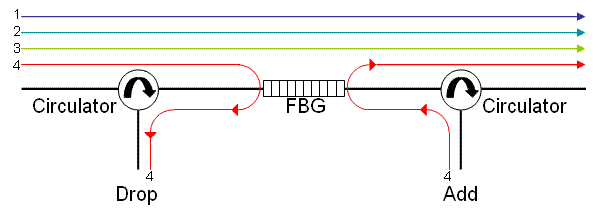
Figure 4. FO circulator used in OADM
|
Polarization Mode Dispersion
Some fiber optic systems experience polarization mode dispersion (PMD), an inherent property of all optical media. PMD is caused by the difference in the propagation velocities of light in the orthogonal principal polarization states of the transmission medium. If the optical pulse contains both polarization components, then the different polarization components in FO circulators will travel at different speeds and arrive at different times, smearing the received optical signal. With optical couplers, optic circulators can correct PMD by rotating the electric and magnetic field of the optical signal. (Shown in Figure 5)
Figure 5. Polarization Mode Dispersion (PMD)
|
|
Chromatic Dispersion Compensation
Optical fiber circulator compensates for chromatic dispersion by using a chipped FBG (wavelength dependent reflector). A section of optical fiber is treated or doped with a material that changes the refractive index of the fiber, causing wavelength dependent reflections. Chipped FBGs have several gratings displaced throughout a fiber and allow for compensation of chromatic dispersion. (Shown in Figure 6)
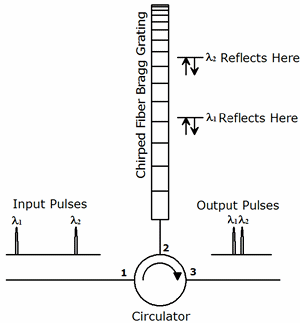
Optical Amplifiers
Optical amplifiers create a direct amplification of a signal without needing to convert it into an electrical signal. Fibermart circulators feed the input signal into the amplifier, receive the amplified signal, and reroute the signal to an output port. In this application the circulator supplies suppressed feedback from the cavity. Figure 7 shows this process.
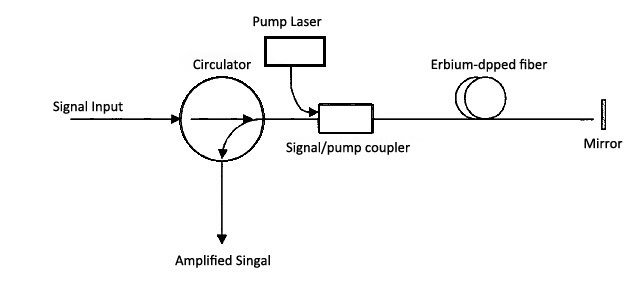
Fiber Optic Sensors
Fiber optic sensors are used to measure parameters such as strain, temperature, and pressure. They use optical Fiber circulators to reroute signals. The high isolation between the input and reflected optical power coupled with a low insertion loss make optic fiber circulator the preferred component for interfacing with fiber optic sensors. Figure 8 shows the setup used to calibrate the FBGs with optical circulator.
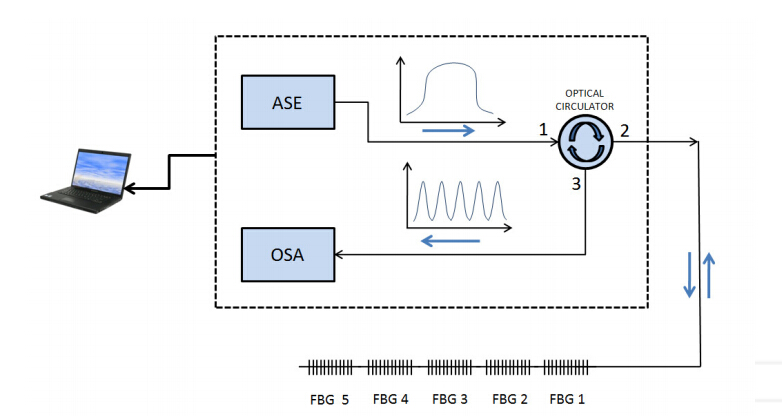
Things To Keep In Mind When Buying Fiber Optical Circulator
When buying a Fiber Optical Circulator, a key component used to direct light in a unidirectional manner within fiber-optic networks, several essential factors must be considered to ensure optimal functionality and compatibility with your system. Fiber Optical Circulators play a vital role in several applications, such as telecommunications, fiber-optic sensing, and test instruments, so selecting the right one is paramount.
· Type of Configuration: Depending on the application, different circulator configurations like 3-port or 4-port might be required. Understanding the exact need for your network will guide you in choosing the right type.
· Wavelength Range: Different optical circulators are designed for specific wavelength ranges. Ensure the device matches the required operating wavelength for compatibility with your existing system.
· Insertion Loss: Lower insertion loss translates to higher efficiency. Compare different models of optical circulators to find a balance between cost and minimal signal loss.
· Isolation: High isolation ensures that the unwanted light is effectively suppressed, improving performance. Look for an optical circulator that offers optimum isolation for your particular application.
· Temperature Sensitivity: Environmental factors, like temperature, can impact the circulator's performance. Consider your operating environment and opt for an optical circulator with proper temperature stability.
· Price and Manufacturer Reputation: Quality often correlates with price, but that doesn't mean the most expensive is the best for your needs. Research manufacturers' reputations and consider reviews to find a reliable product within your budget.
· Compliance and Standards: Ensure the circulator complies with relevant industry standards, as non-compliance might lead to compatibility and safety issues.
Balancing these factors with cost considerations and manufacturer reputation can lead to a selection that seamlessly fits within your fiber-optic system.
Fibre-MART's Optical Circulator Solutions
Fiber-Mart offers both PI and PM circulators (working at 1310, 1550, or 1064nm wavelengths) with 3 or 4 ports. Our optic circulators are featured with high isolation, low insertion loss, and excellent environmental stability. In addition, any other wavelengths, without or with any connector can be customized up to customers' requirements.
-consulting for technical supports or relevent product buying guide
Email for [email protected]











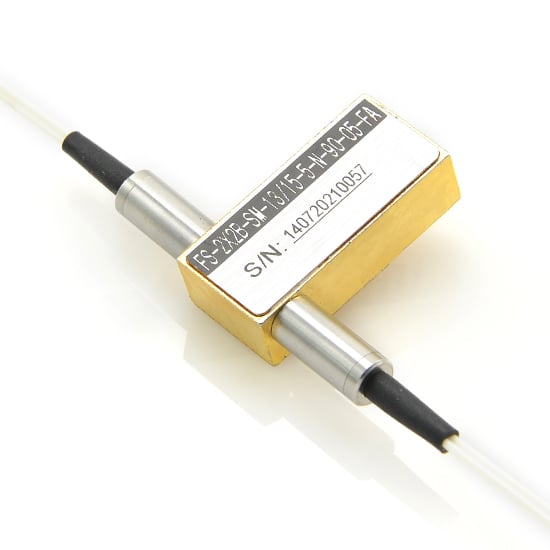
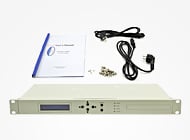
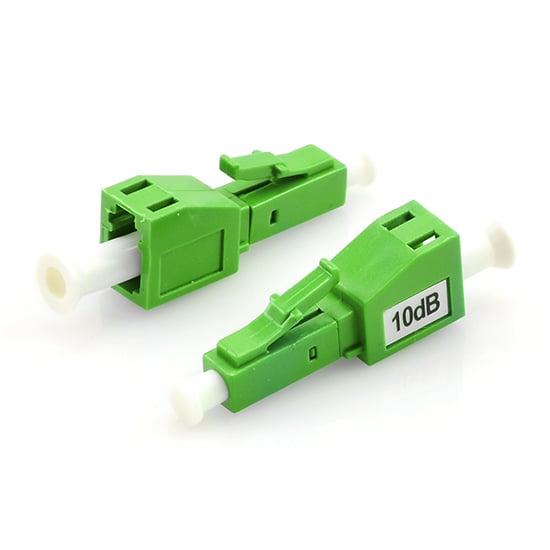



No comments have been posted yet.